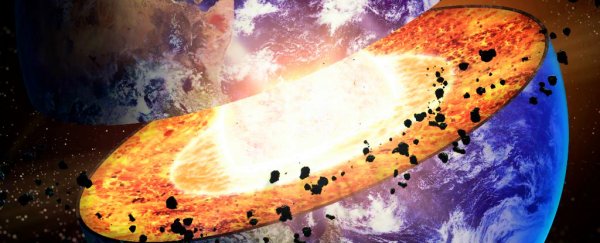It's one of the deepest unknowns in geophysics: the hidden movements of Earth's innermost core.
While we think of the ground beneath our feet as terra firma, that reassuring rigidity only extends so far. Deep below the planet's surface, Earth's super-hot inner core sits within a molten liquid outer core, detached from the overlying mantle and crust above it.
This untethered arrangement poses more than a few questions, perhaps the biggest of which is called super-rotation: if Earth's solid inner core of iron is unattached to the mantle due to the fluid outer core layer that surrounds the inner core, how does that affect its rotation?
Super-rotation hypotheses suggest that Earth's inner core spins at a different rate to Earth's own rate of rotation, which is about one full rotation every 24 hours with respect to the Sun.
Exactly what the inner core's super-rotation rate might be has been debated by scientists for decades. Now, a new analysis by seismologist John Vidale from the University of Southern California offers a fresh estimate for geophysicists to consider.
In his new paper, Vidale examines backscattered seismic waves detected from two separate nuclear tests conducted by the Soviet Union in the Novaya Zemlya archipelago in northern Russia in 1971 and 1974.
When these nuclear explosions were conducted decades ago, the force of the blasts was detected by seismic stations around the world, including the Large Aperture Seismic Array (LASA): the world's first large seismic array, built in Montana in 1965.
By analysing the LASA data and measuring the motion of the inner core based on the seismic waves detected, Vidale estimated the inner core rotated approximately 0.07 degrees more than the rest of the planet each year between 1971 and 1974.
"If his rate's right, it means that if you stood on a spot at the equator for one year, the part of the inner core that was previously beneath you would wind up under a spot 4.8 miles away," Maya Wei-Haas explains in a report on the research for National Geographic.
As far as super-rotation calculations go, Vidale says his new estimate is both slower and more robust than previous approximations, one of which, notably, is his own.
In the year 2000, Vidale was part of a team that analysed the same nuclear test data detected by the Montana array and calculated a faster of super-rotation for the 1971-1974 period, being 0.15 degrees per year.
In the new study, Vidale explains his latest estimate provides greater resolution and benefits from improvements in data correction, processing, and interpretation.
But another reason for why the figures are different is this is a very theoretical field of science – examining a deeply buried, super-heated part of the Earth that's impossible to study up close; the research is still emerging.
The whole theory of super-rotation was only first proposed in the 1970s, but the first serious modelling and seismic evidence only appeared in the 1990s, a few years before Vidale's 2000 research was published.
Scientists have other explanations too for why our readings and estimates on the inner core's seeming super-rotation rates might differ.
A study published in May suggested the discrepancies could be down to variations in the surface of the inner core itself, which could explain inconsistencies in other analyses.
If that view is correct, it means we could be dealing with an even greater unknown down in the centre of the Earth. Only time, and lots more scientists willing to take on the challenge, will tell.
The findings are reported in Geophysical Research Letters.
